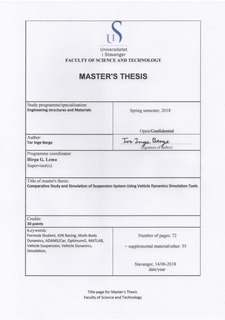| dc.contributor.advisor | Lemu, Hirpa G. | |
| dc.contributor.author | Berge, Tor Inge | |
| dc.date.accessioned | 2018-09-11T09:14:23Z | |
| dc.date.available | 2018-09-11T09:14:23Z | |
| dc.date.issued | 2018-06-14 | |
| dc.identifier.uri | http://hdl.handle.net/11250/2561940 | |
| dc.description | Master's thesis in Mechanical engineering | nb_NO |
| dc.description.abstract | With the increased availability of computing power, simulation tools has become more available for the average user. This has led to a lot of specialized software for most simulation needs. In Formula Student vehicle dynamics simulation software is used to determine the handling of the car being designed, before it is built. This gives the students a possibility to try different solution on the computer, before choosing which one to use on the real car. This thesis will study the results from three different vehicle dynamics simulation software. These results will be compared with each other and measured values to see if the simulations give realistic results. The software chosen for this study is: MATLAB OptimumG Software package ADAMS/Car These three software have a different degree of complexity and skill level needed to setup and run simulations. As time is the most valuable commodity in the Formula Student design process, easy and fast setup and simulations is important. The tools will be compared based on the generated results and the time needed to setup and simulate the models. As a reference three simulations will be done: Kinematic suspension motion Roll Stiffness Acceleration event Kinematic suspension motion and roll stiffness will base their measured results on Bifrost, while the acceleration event will base its reference on results from previous Formula Student competitions. This is because Bifrost have not been tested in acceleration at the time of writing. Each of the software bases their simulation inputs on ION Racing UiS’s 2018 car Bifrost. By using the same source of input the results will only vary based on how the software solves the simulation. By comparing the results with measurements collected from the actual vehicle, comparisons on the accuracy of the simulations can be done. i From the kinematic simulations and measured results, the simulations did not deviate more than the uncertainty in the measured results. The toe measurements in heave and roll motion was deviating from the simulations. This is most likely because of the small variations in toe in both heave and roll, and that the test rig was not stiff enough to give consistent measurements at the same resolution as the simulation. The roll stiffness in both calculated and simulated values was close to the measured value. There was some difference in the rear roll stiffness in the simulation, but it was not possible to measure this, as the test rig was only able to measure total roll stiffness. In the acceleration simulation, all of the simulated values was lower than what have been performed by top teams in the competition with a rear wheel drive car. The best times in acceleration at competition is 4.1 sec. The results from the simulations varied from 3.5-3.9 sec. Most likely this is a result of inaccurate inputs, which again gives inaccurate outputs from the software. With this knowledge of how the simulated results compare to real world tests, better understanding of the results is achieved and better decisions can be made in the future. | nb_NO |
| dc.language.iso | eng | nb_NO |
| dc.publisher | University of Stavanger, Norway | nb_NO |
| dc.relation.ispartofseries | Masteroppgave/UIS-TN-IMBM/2018; | |
| dc.rights | Navngivelse 4.0 Internasjonal | * |
| dc.rights.uri | http://creativecommons.org/licenses/by/4.0/deed.no | * |
| dc.subject | maskinteknikk | nb_NO |
| dc.subject | maskinkonstruksjon | nb_NO |
| dc.subject | ION Racing | nb_NO |
| dc.subject | ADAMS/Car | nb_NO |
| dc.subject | OptimumG | nb_NO |
| dc.subject | MATLAB | nb_NO |
| dc.subject | multi-body dynamics | nb_NO |
| dc.subject | vehicle suspension | nb_NO |
| dc.subject | vehicle suspension | nb_NO |
| dc.subject | simulation | nb_NO |
| dc.subject | Formula Student | nb_NO |
| dc.title | Comparative Study and Simulation of Suspension System Using Vehicle Dynamics Simulation | nb_NO |
| dc.type | Master thesis | nb_NO |
| dc.subject.nsi | VDP::Teknologi: 500::Maskinfag: 570::Maskinkonstruksjon og materialteknologi: 571 | nb_NO |

